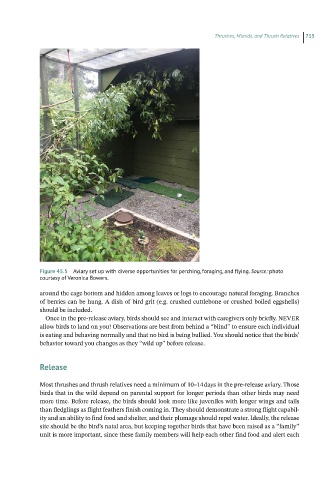Page 713 - Hand rearing birds second
P. 713
Thrushes, Mimids, and Thrush Relatives 715
Figure 45.5 Aviary set up with diverse opportunities for perching, foraging, and flying. Source: photo
courtesy of Veronica Bowers.
around the cage bottom and hidden among leaves or logs to encourage natural foraging. Branches
of berries can be hung. A dish of bird grit (e.g. crushed cuttlebone or crushed boiled eggshells)
should be included.
Once in the pre‐release aviary, birds should see and interact with caregivers only briefly. NEVER
allow birds to land on you! Observations are best from behind a “blind” to ensure each individual
is eating and behaving normally and that no bird is being bullied. You should notice that the birds’
behavior toward you changes as they “wild up” before release.
Release
Most thrushes and thrush relatives need a minimum of 10–14 days in the pre‐release aviary. Those
birds that in the wild depend on parental support for longer periods than other birds may need
more time. Before release, the birds should look more like juveniles with longer wings and tails
than fledglings as flight feathers finish coming in. They should demonstrate a strong flight capabil-
ity and an ability to find food and shelter, and their plumage should repel water. Ideally, the release
site should be the bird’s natal area, but keeping together birds that have been raised as a “family”
unit is more important, since these family members will help each other find food and alert each

